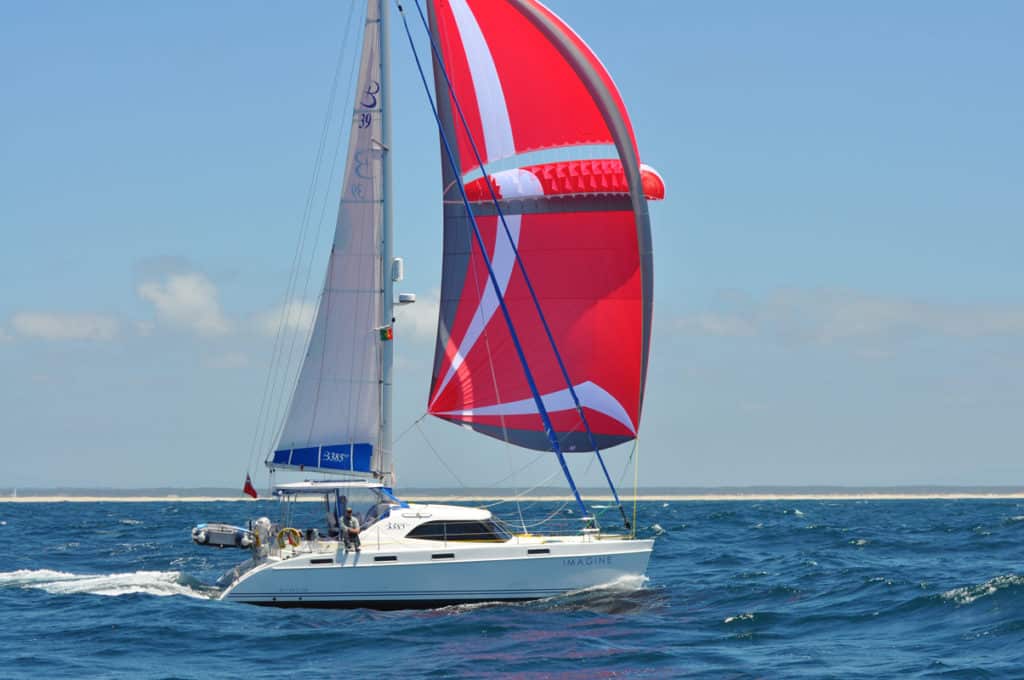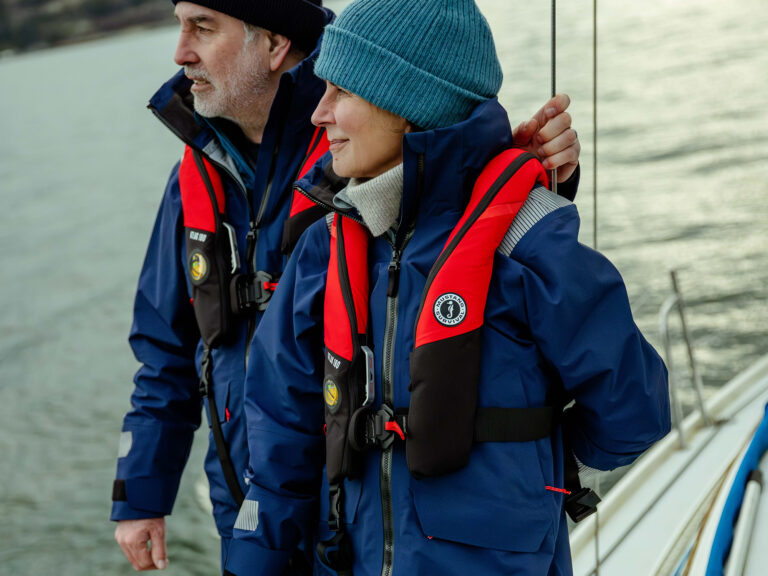
Turning onto a beam reach, I nudge the wheel, and Robert Underwood of Broadblue Catamarans winches up the traveler; there’s a sudden but gentle sense of acceleration. With a scant 7 knots of wind at the masthead, the cat settles in at 7 on the speedo as well and quietly glides across England’s Solent. It’s an idyllic afternoon, and in a daydream state, I envision my next landfall, somewhere in the Bahamas. If not for Robert’s prompt to tack-to prove how easily his boat tacks-I might’ve ended up there. Now the helm goes over, the headsail slaps across, and the Broadblue 385 settles on the other tack without fuss. The apparent wind has swung from 40 to 40. Not bad at all for a cruising cat.
Such nimble light-air performance is probably due in equal parts to the 385’s efficient hull profile and its unusual Aft Rig, a unique sail plan that steps the mast at the main bulkhead. (See the drawing.) The Aft Rig mainsail is only 304 square feet, while the genoa, at 534, really pulls the bows across the wind. This rig is ideal for coastal cruising and daysailing, especially when shorthanded. The full-battened Sport Rig, with its large-roach main, offers more horsepower and may be faster for passagemaking.
Peter Thompson, a 45-year-old dentist from Lancashire, England, expects to log more than 8,000 miles this year on his 385 Aft Rig. “For family sailing, the small main is great,” he says. “It’s easier to handle and you don’t have to reef as soon.” If he were to do it again, however, he says he’d choose the Sport Rig for its upwind performance. To bolster his inventory for the 2008 Atlantic Rally for Cruisers, he’s added a spinnaker.
In a multihull world populated with cats designed for charter fleets, Broadblue touts its line of boats as “true bluewater cruisers” and builds to Category A (Oceangoing) standards in the European Union. Below the waterline, the hulls are solid glass reinforced with Kevlar in loaded areas. Above the waterline, hulls and deck are balsa-cored laminates with marine-grade-plywood reinforcement at hardware locations. Other offshore-enabling attributes include five bulkheads, flotation compartments, and hardened glass windows set in aluminum frames.
The 385 we sailed had a three-cabin layout, with a large shower/head forward in the starboard hull and a smaller walk-through head/shower to port. The alternative, twin-stateroom layout offers two double-berth cabins and two pilot berths. Our test boat featured an office area amidships in the port hull; our sea-going dentist says that he and his two daughters use it a lot at sea.
In the saloon, there’s a generous U-shaped dinette, full galley, and nav station. The galley may leave one wanting for counter space, but the layout does add to the open, airy feel of the 385’s common area. Our test boat had been extensively cruised, and even with cruising cargo, it felt lively enough. But after only a light-air test sail, I asked Peter Thompson to provide a description of sailing in more memorable conditions:
“I was with my wife, going around Land’s End at about 2 in the morning,” he said, “and it was blowing Force 8. She turned to me and asked, ‘Are you happy?’ I said, ‘I’m happy as hell.’ And she said, ‘That’s a good answer.’ But from a more pleasant point of view, the best time so far was our four-day passage to Lanzarote, in the Canary Islands, with the kids. Just walking around the boat and enjoying being at sea.”
Dave Reed is the editor of Sailing World, CW’s sister publication.
Review # 2
The Broadblue 385 was designed for couples who want to cruise offshore and in the often-atrocious weather around Britain. It meets the highest European Union boatbuilding standard, which can be seen in its six floatation compartments and aluminum-framed glass windows. It’s not a heavy design, but because it’s meant to carry full provisions without a significant drop in performance, it’s no racer either. Unfortunately, my test sail in light winds proved little on this score.
The hulls have a relatively fine entry but plenty of reserve buoyancy. Unlike many competitors, the Broadblue has a long bridgedeck that creates extra stowage space beneath. It has 30 inches of clearance forward, but it appeared to be more prone to slamming than a boat with a trampoline forward.
The hull’s are Polish-built and finished in the United Kingdom. They’re solid glass, .5 to 1.25 inches thick below the waterline, with Kevlar reinforcing in high-load areas. Elsewhere, the hulls are cored with end-grain balsa, as are the decks. The skeg-hung rudders are the same depth as the keels, which allows the boat to be beached for maintenance, thus avoiding the hassle of finding a yard that can haul a cat, which can sometimes prove difficult in foreign ports. The keels are integrally molded with the hull and sealed off, making them the first defense against damage should the boat be accidentally grounded. They’re each fitted with a stainless-steel shoe, making damage less likely.
On deck, the cockpit’s comfortable, as you’d expect on a catamaran, with a raised helm seat on the port side that offers good visibility and easy access to sail and engine controls. Our test boat had the optional fiberglass bimini top, which has Visquine (plastic) windows forward that roll up when the crew want air. Going forward, the decks are wide and clear of obstacles. There’s a centerline step in the front of the house that makes getting to the cabin top easy. The foredeck extends most of the way to the bows and provides storage and a platform for the centerline anchor and windlass.
Two rig configurations are available: The Sport Rig, with the mast at the forward end of the house, features small headsails and a big, roachy main for drive; the Aft Rig positions the mast at the aft end of the house and uses bigger jibs with a much smaller high-aspect main.
Belowdecks on the Broadblue, it’s obvious that this cat’s designed for extended cruising because there’s a ton of storage space. In the configuration of the boat I sailed, both hulls have a spacious aft cabin with large hanging lockers. In the port hull is a desk and chair at the foot of the steps from the saloon; forward is a large head with a separate walk-in shower. On the starboard side, instead of the desk, there’s a huge extra refrigerator/freezer; forward is a head with an integral shower, and in place of the stall shower is room for a workbench and tools. A three-cabin layout with two doubles in the starboard side is also available.
The saloon is comfortable and airy, with a workable, attractive galley and seating for six around the dinette; a small nav station with a swing-out stool is aft to port.
In the wind in which I sailed the boat, it seemed a bit undercanvased, but in such conditions most cruisers would be running the 20-horsepower Volvos. On this boat, equipped with saildrives, the engines ran relatively quietly.
The Broadblue 385 will suit sailors who place higher priority on seakeeping properties and ability to carry stores for extended, comfortable cruising than on exciting performance and fast passages.
Andrew Burton is a CW associate editor.
Broadblue 385
LOA 38′ 8″ (11.79 m.)
LWL 35′ 9″ (10.90 m.)
Beam 19′ 7″ (5.97 m.)
Draft 3′ 5″ (1.04 m.)
Sail Area 777 sq. ft. (72.2 sq. m.)
Displacement 15,876 lb. (7,201 kg.)
Water 125 gal. (473 l.)
Fuel 132 gal. (500 l.)
Engines Two 20-hp. Volvos with saildrives
Designers Simon Davidson and Robert Underwood
Price $356,000
Broadblue Catamarans Ltd.
(252) 249-0358
www.broadblueusa.com








